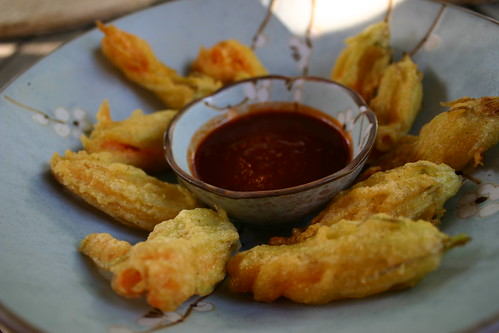
As many of you already know, early last month, I went to the White House for the launch of the
Chefs Move to Schools Initiative. On a day in June that felt more like August, approximately 600 chefs, cooks, and culinary instructors descended upon our nation’s capitol, toured the year-old garden and sweated through our “whites”. Much has been written on the event in the press and the blogosphere, mostly rah rah pieces just a breath away from puff, with an occasional
tempered assessment. It was my intent to post on the event soon after my return, but a number of other commitments gave me a legitimate excuse for procrastination. Procrastination led to percolation and finally, I’ve gotten around to writing up my view, an unvarnished one of Chefs Move to Schools.
The Chefs Move to Schools program is part of First Lady Michelle Obama’s anti-obesity campaign. The
Let’s Move campaign seeks to spread its fingers into society in several directions: early childhood, food deserts, physical activity, and, of course, schools.
The “Chefs Move to Schools” program, run through the U.S. Department of Agriculture, intends to pair chefs with interested schools in their communities “so together they can create healthy meals that meet the schools’ dietary guidelines and budgets, while teaching young people about nutrition and making balanced and healthy choices.”
I had advance knowledge of the program from friend Rochelle Davis, executive director of
Healthy Schools Campaign, who’d told me that Sam Kass wanted to create a chef corps for schools. So I was unsurprised to receive the email from Let’s Move announcing the program in early May. I was, however, pleasantly surprised to find myself invited to the launch.
Living dangerously, I flew in the morning of the event after a late night catering. My turbulent flight, canceled once, arrived at 9, only an hour prior to the opening of the gates. I was impressed by both the humility and humanity of Marcus Samuelson who waited patiently in line with the rest of us at the head of the long snaking line down the street.
Making it through security, two check points and some finely tuned metal detectors was a thrill. Being one of the first through the gates, I took a leisurely stroll through the garden. As the sea of white chef coats, dotted with a few pink, denim, and even a tie-dye one, rolled in, we were escorted to the orderly formation of seats in the hot sun of the south lawn.
Given that the sun was beating down on us, the presentation, thankfully, was brief. Chef Sam Kass provided an introduction to his East Wing boss. The first lady then presented an example of her view of a successful chef/school partner: Each of the two halves described their experience. After FLOTUS’ conclusory remarks, the event ended and we departed.
And this is where my story begins.
Obviously, given what I do, I am very supportive of the First Lady’s initiative. Childhood obesity, hell, obesity in general is a scourge that our country can’t seem to shake. The repercussions from this condition are wide-ranging – increased health care costs, decreased self-esteem, and just generally making us an unhealthy society. This being said, why am I not as gung ho about the Chefs Move to School program as many of the other blogging participants? I have a few concerns.
It’s been two month since the program was announced and a month after the launch and it still is not clear what it means for a chef to “adopt” a school. Are we looking at the Jamie Oliver-Food Revolution model or Alice Water’s Edible Schoolyard? How much time is a chef expected to volunteer? How will the schools and chefs be paired? How is the USDA recruiting schools? How does an initiative like this work in districts like Chicago, which is comprised of 100’s of schools?
Since signing up through the USDA website, I’ve only seen one email from the powers that be – one that passed along a request from Epicurious for chefs to demo at the Daley Plaza farmers’ market. It does seem that with all of the resources at the USDA’s and First Lady’s disposal, that we would have received some direction by now.
On the positive side, the lack of direction from the Let’s Move initiative on this program should allow individual schools, districts, and individual chefs to create programs that work best for their communities. But this does require more effort and time from the individual chefs, which leads me to my second concern.
Without a clear understanding of what it means to adopt a school, how can a chef make a firm commitment to participate in the program? The brief description found on the USDA’s website seems to imply that it would like chefs to both improve the food served in schools AND provide nutrition education. From my experience of working in the schools for the past 5 years, to do even one of these two would require a significant commitment of time and resources. It’s a pretty big ask even if funding were involved. But the USDA and the White House have requested that this all be done on a volunteer basis.
Chefs are a busy bunch. They work hard, long hours and it’s hard to believe that many would be able to fit in the many hours that Chefs Move to Schools really requires. From my research, it appears that the inspiration for this program came from Slow Food’s
Edible Schoolyard and New York City’s
Wellness in the Schools, both of which are sophisticated and well-funded. There are other models as well including Art Smith’s
Common Threads and Gracie Cavnar’s Houston based
Recipe for Success. I am hoping that when some direction comes from the White House/USDA, they recommend chefs seek out organizations like these in their communities, ones with the resources, connections, and institutional knowledge to help chefs effectively work in the schools.
Here in Chicago, we’re doing just that by co-convening a meeting with
Share our Strength and
Healthy Schools Campaign where participating chefs will learn about the new nutrition standards that will be in effect in the coming school year and CPS’
Go for the Gold partnership with Healthy Schools Campaign, to help individual schools meet the gold standard of the U.S. Healthier Schools Challenge. They’ll also hear from organizations, like mine, about working in the schools either as individuals or within the context of another entity. We don’t want to dampen anyone’s enthusiasm, but instead help translate that enthusiasm into effective action. I also hope that it will encourage some of the chefs to work in some of the more underserved communities, which leads me to my final concern.
The USDA has not stated how chefs will be partnered with schools. The website states that it will “pair chefs with interested chefs in their communities.” But what does a community make? In Chicago, is it the city or is a neighborhood? If the latter, from looking at the
map, there will be plenty of chefs for the north side, but there are very, very few on the south and west, neighborhoods that coincide with the greatest need for nutritional assistance. Yet again, these communities will be underserved. Unless the USDA makes some attempt to equitably divide the resources of the Chefs Move to Schools, it will only serve to perpetuate social inequities.
On the subject of social justice, I was a bit surprised to see that the USDA has allowed private schools to sign up for the Chefs Move to School program, at least one of which in Chicago has a tuition that ranges from between $22,000 (for JK) to $35,000 for high school. When I posted an informal poll on my facebook page, many suggested that regardless of tuition, all kids should be taught good nutrition. Agreed. However, I do feel that private schools, especially one with ample resources, shouldn’t be looking for volunteers through this program. Certainly, if a chef has a personal connection to this school, the story is different. For example, I founded a wellness committee for my son’s school, another Chicago private school; nevertheless, I view that as fulfilling my volunteer commitment to his school, not as part of the Chefs Move to Schools. With close to 700 public schools in CPS, I feel strongly that the resources of Chefs Move to Schools should be used to support those schools, especially because the infrastructure of the program is supported by our tax dollars.
Obviously, the intent behind the Chefs Move to Schools – getting new creative ideas from food service professionals – is excellent. I’m sure with a little consideration of these concerns, the USDA, the White House, and individual communities can address them. So I ask you readers, how would you deal with my criticism of the program?














